Quote
BACKSTORY HAS A NEW HOME ON THE ABC NEWS WEBSITE
Click here to go to the new site:
www.abc.net.au/news/about/backstory
1 note
·
View note
Quote
BACKSTORY HAS A NEW HOME ON THE ABC NEWS WEBSITE
Click here to go to the new site:
www.abc.net.au/news/about/backstory
1 note
·
View note
Text
HOW A ROUTINE COURT CHECK LED TO A SCOOP ABOUT RUGBY LEAGUE PLAYERS ALLEGEDLY BUYING COCAINE

(Canberra based High Court reporter Elizabeth Byrne - Photo: Greg Nelson)
High Court reporter Elizabeth Byrne is usually busy covering legal cases of national significance, but during a routine check of matters at a local ACT court she uncovered a sensational story about a Canberra man charged with allegedly selling cocaine to two high-profile rugby league players.
By Elizabeth Byrne
There's a police camera in Canberra parked permanently on a pole outside two of the city's most notorious clubs. I've seen its images a few times now.But on Saturday, May 6, police monitoring the camera saw something that really got their attention. Two men, claimed by police to be Captain of the Kiwis Rugby League team, Jesse Bromwich, and his teammate Kevin Proctor, casually rolling up a banknote each, and snorting in turn what is alleged to be cocaine from the face of a smart phone held out by a man identified by police as Adrian Mark Crowther. The pair had just suffered a thumping defeat in the Anzac Test. The two men had left by the time police arrived to arrest and charge Crowther.
Now Saturday morning court isn't a popular assignment in the ACT Newsroom, and that day I had drawn the short straw. After some routine checks, I decided to wait for the prosecutor to get more details on a domestic violence case.
It turned out to be a fortunate decision. But before I could speak the prosecutor said, "Are you waiting for Crowther?"
"What did he do?" I asked, hopefully.
Then the court clerk weighed in: "It was footballers, from some football match?"
"Not the Anzac test?" I said.
I'd previously written a story about one player, Josh Papalii, who’d been excluded from the Test team after he pleaded guilty to drink driving, having called the police on himself.
I decided I should stay a bit longer to find out more. We waited and waited until the Magistrate threatened to go home. The police were still putting together a case to hold Crowther in custody. There's a problem with holding someone in custody for more than 48 hours.
Eventually, a young officer appeared, and Crowther was brought in. The charge was read, and the prosecutor laid out the case, including that he was alleged to have supplied cocaine to two NRL players and named both Proctor and Bromwich.
Crowther got bail and I got the statement of facts, but the players weren't named in it. However, they were named in court, which meant that we could therefore report it. So, I broke the story, which was big news and was picked up by other news organisations.
Triple M invited me on their show, every friend I ever had in commercial TV was on the phone, the New Zealand Herald contacted me, and Mark Jessop, the toughest of old Channel Nine cameramen at Parliament House, congratulated me!
It was a scoop that caught everyone by surprise, including the police. During a conversation the next day, I was casually interrogated, about how the players’ names got out. It appears the police had planned not to name them but the prosecutor did name them in court.
And the lesson for all reporters is you never know when a dull assignment might turn into a lead story and you don't have to be in the sports department to break a really, really big sports story. Oh, and footballers often provide really great stories.
Adrian Mark Crowther will return to court at a later date.
Jesse Bromwich and Kevin Proctor have not been charged with any offence. In a statement via the Melbourne Storm, Jesse Bromwich apologised for making “poor choices” in staying out late and drinking an excessive amount of alcohol and has been sanctioned by his club.
Proctor also released a statement through his club, the Gold Coast Titans, saying the night was a “bit of a blur” and while he could not remember the incident, he did not deny it occurred. He apologised for drinking too much and stood down as co-captain.
1 note
·
View note
Text
FAREWELL TO THE ‘DREAM FACTORY’ AS 60 YEARS OF TV PRODUCTION AT RIPPONLEA STUDIOS COMES TO AN END

(Filming of the final program of ‘The World of Operatta’ at the Ripponlea studios in 1964 - Suzanne Steele is singing ‘Paradise in Waltz Time’ in a bubble bath! - Photo: ABC archives)
After 60 years, production at the ABC’s Ripponlea TV studios is winding down and staff are moving out to refurbished headquarters at Southbank. Australian Story producer Belinda Hawkins, cameraman Mark Farnell and set buyer/dresser Andrew Best share their memories of working at the station, which dates back to the start of television and has been home to many of Australia’s iconic programs.
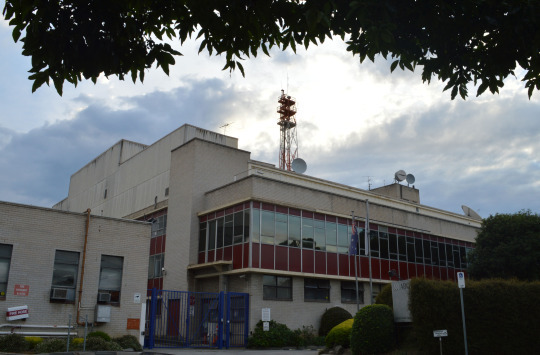
(The ABC studios in Gordon Street, Elsternwick date back to the start of television in Australia - Photo: Natasha Johnson)
By Natasha Johnson
The sparkle has faded, the paint is peeling, and the whole building looks generally worn out. Built in the 1950′s, the Ripponlea TV station has asbestos (safely contained) in the walls and parts of the site are prone to flooding, but when Australian Story producer Belinda Hawkins talks about it closing her voice breaks and her eyes fill with tears.
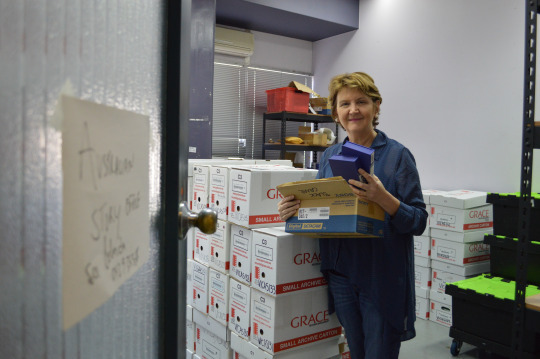
(Australian Story producer Belinda Hawkins has spent weeks sorting, boxing and cataloguing 17 years of tapes - Photo: Mark Farnell)
“Everyone who had anytime here, who is packing up now is beside themselves with sadness,” says Belinda.
)
Most of her News colleagues moved to the ABC’s Southbank studios more than a decade ago, but Belinda Hawkins has stayed put, working out of an office that was once a film viewing room and still has bits of an old film cleaning machine hanging in a storage cupboard.
“I think I will burst into tears when we leave. I’m leaving my history.”

(Set buyer/dresser Andrew Best in the props department - Photo: Natasha Johnson)
It’s a sentiment shared by Andrew Best, set buyer/dresser and unofficial ‘historian’ who has worked at Ripponlea for 36 years and occasionally conducts public tours of the site.
vimeo
VIDEO: TAKE A TOUR BEHIND THE SCENES OF THE RIPPONLEA STUDIOS, WARDROBE AND PROPS DEPARTMENTS WITH ANDREW BEST
“It’s time to move on, but I’m very sad actually,” says Andrew. “I think after nearly 36 years here, that’s over half the time that TV has been in Australia, you feel very attached to somewhere you come to every day and have made so many wonderful friends and helped create so many fantastic things, it is very difficult to leave.”

(A flyer announcing the official opening of the ABC studios in 1958 - supplied: Andrew Best)
Attachment to the old brick building, known affectionately by staff as “Rippers’, stems from its place in the history of television production. The studios, in Gordon Street, Elsternwick, date back to the start of TV in Australia. The ABC started broadcasting in Victoria in 1956, in time for the Melbourne Olympic Games, and the completed studios were officially opened in 1958.
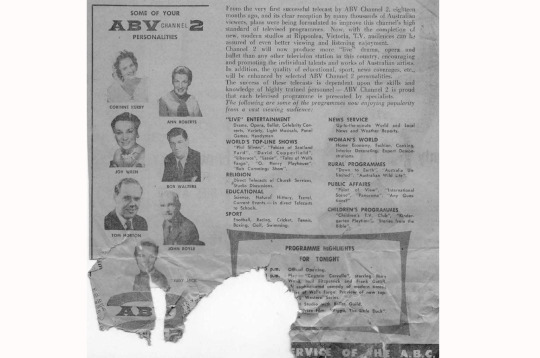
(A flyer promoting the programs and personalities on ABV2 at the time of the official opening of the studios in 1958 - supplied: Andrew Best)
Since then, a host of iconic Australian programs, dramas, and variety shows have been produced at Ripponlea, including the children’s show Adventure Island, sixties soapie Bellbird, period drama Power Without Glory, Countdown, The Gillies Report, The Big Gig, SeaChange, Kath and Kim and, more recently, Mad as Hell and The Weekly.

(Children’s show ‘Adventure Island’ being filmed at Ripponlea in the 1960′s - Photo: ABC archives)
“In the sixties this was called the ‘dream factory’ because it was the beginning of TV and really anything you could dream up was new and exciting and you could create it here. I think latterly I’ve thought of it as Hollywood by the Bay because we’ve had a lot of stars go onto Hollywood and alike,” says Andrew Best, who has worked alongside many of them, including Hugh Jackman, Eric Bana, Sigrid Thornton and Kerry Armstrong.

(Andrew Best on location with actress Kerry Armstrong during filming of ‘Bed of Roses - Photo: Andrew Best)
“It does really have that feeling that just anything could happen here and so many wonderful shows have come out of here.”

(Filming ‘Countdown’ at Ripponlea - Photo: ABC archives)
The studios were built on land that was originally part of the historic Rippon Lea Estate, a location which has caused some headaches over the years.
“The studios border the back end of the Rippon Lea gardens where there is a large lake and this was essentially swampland,” says Andrew Best.

(Inside Studio 31 where ‘The Weekly’ is currently being produced until moving to the new Southbank studios - Photo: Natasha Johnson)
“So if we have extreme rain the studios and scenic runway behind them can be deep in water. We’re also next to a railway line and quite often in the fifties and sixties when trains went by they would make the entire lower level of the building shake and the cameras in the studio would be wobbling. It’s been fixed since with thick concrete floors, but in the early days people would say “Oh, I think that’s the 5.09 to Sandringham going by”, it was that rattly.”

(Belinda Hawkins as a young news reporter - Photo: Belinda Hawkins)
Belinda Hawkins started at Ripponlea in 1985 as a 28 year old News cadet, having abandoned a teaching career to chase her dream of being a journalist.
“The first day I walked in here and got my ABC lanyard I thought I’m off on a magic carpet ride, I can go anywhere and talk to anyone I want, and I have never stopped feeling that way. I remember the first time I watched the news go to air and I just thought this is the best theatre in town. The newsroom was on the second floor, The 7.30 Report was below us and the studio was on the ground floor and there was a constant stream of people running up and down the stairwell, heading out on a story or a ‘scramble’ as it was called then or rushing scripts into the studio.”

(The stairs leading from the ground floor studio to the old newsroom on level two - Photo: Natasha Johnson)
“Everyone smoked and the newsroom was full of smoke. There was a constant buzz of noise in the newsroom: the clatter, clatter, clatter of typewriters, people shouting across the room, and there was a police scanner going all the time. A two-way radio was used to communicate with crews on the road and we had a Chief of Staff, Roger Delisle, who had been in the navy and he’d bark on the two-way “What is the SITREP on your ETA? Over!” I thought it was hilarious.”
vimeo
VIDEO: Rewind to see how the news was produced at Ripponlea in 1979
“In those days, (before automated studios), there were lots of people behind the cameras, in the studio and in the control room. The autocue script had to be put together manually - now it’s all computerised - and there were all these people frantically sticking sheets of paper together. There was just this enormous theatre involved in getting the news to air.”

(Cameraman Mark Farnell has worked at Ripponlea for 33 years - Photo: Natasha Johnson)
Cameraman Mark Farnell has been based here for 33 years and worked on a wide range of news, current affairs, arts and education programs. Starting in 1983, he was one of the last employees to be put through a three year traineeship program, learning all aspects of television production.

(Mark Farnell - second row, far right - with his fellow trainees in 1983 - Photo: ABC archives)
“It was an exciting, vibrant place to work,” Mark recalls. “There was a sense of being amongst the ‘bright lights’ and you’d pass people like Molly Meldrum and Max Gillies in the corridor.”
“There was lots of money going into TV production and, because it was then very labour intensive, there were lots of people working here and it was a 24/7 operation. A lighting crew would work overnight getting studios ready and there’d be a big technical crew on deck from 5am to ‘line up’ (calibrate) all the studio cameras.”
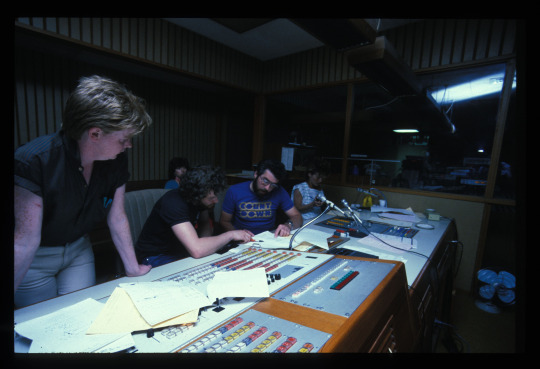
(In the control room during production of Countdown - Photo: ABC archives)
“It was less ‘serious’ then and there was lots of fun and games behind the scenes. I remember working in telecine one day and I’d laced up the machine with a film reel ready to go to air in the news and, without me realising, one of my colleagues flicked the switch to reverse so when the director hit roll it went backwards. No one got that upset about it. It was accepted that things went wrong and that people made mistakes. My trainer, Billy Wright, told us “If you make a mistake don’t worry about it, it’s only TV, not brain surgery!”
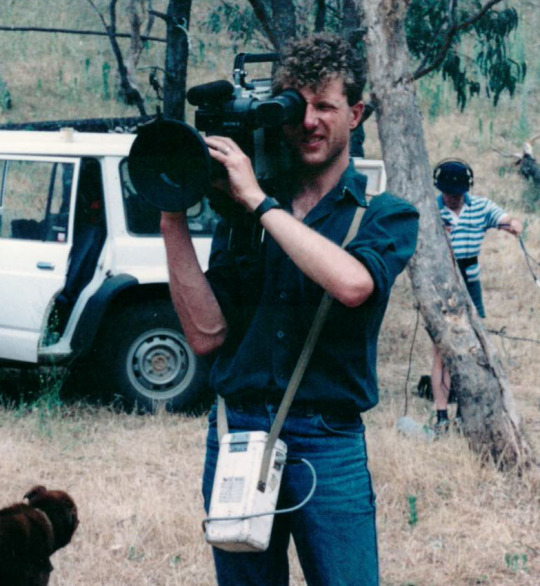
(Mark Farnell shooting a story in the early years of his career - Photo: Belinda Hawkins)
Mark Farnell first learnt to shoot on film and recalls how the medium required efficient and economical shooting.
“You couldn’t over shoot because the film had to be processed and it was expensive. You would very rarely run through a 400 foot roll, which was about 8 minutes. You had to get the footage back to the lab by 4pm to make the 7pm news. You wouldn’t go to a press conference and just roll endlessly on an interview. The journalist’s job was to ‘rehearse’ with the talent off camera so you could record the right answer straight up. It was liberating when we moved to video, and later digital cameras, because we could shoot a lot more material. There’s a lot less discipline in what we shoot now because we can accumulate huge amounts of material, but it’s opened up that ‘fly on the wall’ ability to capture the perfect moment that was hard to capture on film.”
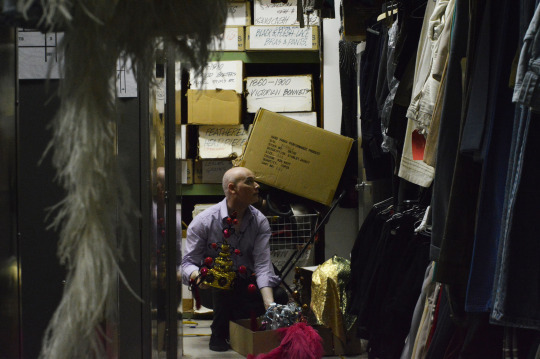
(Set buyer/dresser Andrew Best in the wardrobe department - Photo: Natasha Johnson)
Andrew Best started in dispatch in 1981, moved into staging and then became a buyer/dresser in the Art Department. His job is to realise the visions of designers and producers and make the sets ‘look real’. There’ve been some challenging moments along the way.
“I remember one designer insisted he didn’t want to see anything red on set, no red! I once got 10 different samples of a brown carpet and the designer still wanted a shade of brown between two samples that already looked pretty much alike. When I was working on Countdown and Cindi Lauper was performing ‘Girls Just Wanna Have Fun’, her manager kept screaming “I want more trash cans, we need more trash cans” for her set. It can be a frantic job, but it’s intensely rewarding.”

(Cindi Lauper on the Countdown set with host Molly Meldrum - Photo: ABC archives)
When dressing a set, first stop is always the ABC props stores, which Andrew Best fondly describes as looking like “the world’s biggest op shop”. And he’s not wrong.
“Some people think of it as the city tip, but to me it’s heaven on earth, you can find amazing things in here.”

(The props department, which Andrew Best describes as looking like “the world’s biggest op shop” - Photo: Natasha Johnson)
He insists there is a system to it, but to the untrained eye there seems to be just row after row, shelf after shelf of piles of junk: various styles of suitcases, telephones, crockery, furniture, paintings, toys, medical equipment, bathroom toiletries, a dozen different types of sticky tape dispensers and jars of lollies, well past their use by date.

(”Never throw anything out” says Andrew Best, even stale lollies - Photo: Andrew Best)
“The thing about a props store is that you always reuse everything, you never throw anything out, even when the mice have made a home in it, because you never know when the script is going to say ‘cereal box with mouse droppings in the bottom of it’!”

(An old pram amongst a props storeroom of furniture from different eras - Photo: Natasha Johnson)
Many of the props have been created by the ABC Art Department and among Andrew Best’s favourite items are rubber replicas of old Melbourne street lamps that were first used in Power Without Glory in the 1970s, hollow wooden blocks of books used to fill the shelves of numerous legal dramas (cheaper than real books) and a mauled wombat head, which was made for an episode of Bed of Roses, starring Kerry Armstrong.

(Andrew Best with one of his favorite props, a very realistic mauled wombat made for an episode of ‘Bed of Roses’ - Photo: Natasha Johnson)
“One of the story lines was that there was a panther on the loose around the country town where the show was set and one of the scenarios had a little girl coming across a wombat that had been eaten. This beautifully made prop cost about $1500 and two weeks to make and it is incredibly realistic.”

(Andrew Best with the wombat head on location during filming of the ‘Bed of Roses’ episode - Photo: Andrew Best)
As well as a vast props collection, the ABC has an enormous range of costumes, stored in several rooms at the Gordon Street site and the neighbouring Selwyn Street offices, where staff are also relocating. The collection, stretching back 60 years, includes many outfits handmade by the ABC wardrobe department and pieces are often hired out for external productions.
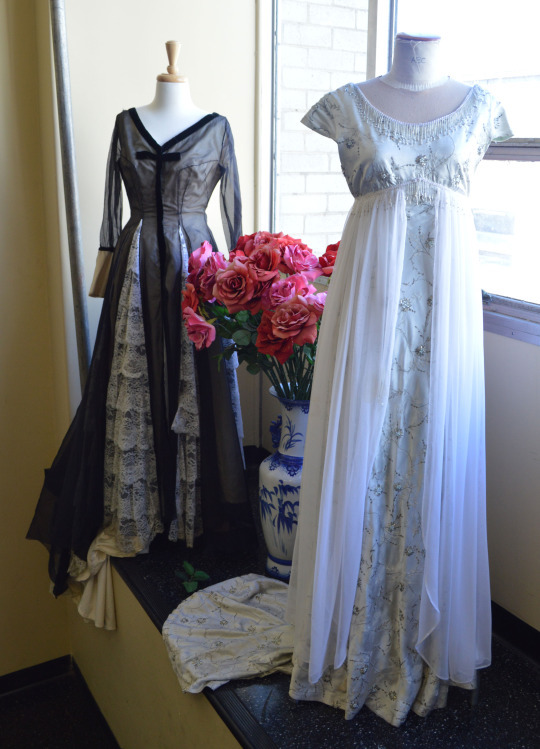
(A couple of gowns from the wardrobe store, which has thousands of costumes dating back to the start of television - Photo: Natasha Johnson)
“In the early days, we didn’t have a huge supply of clothing so a lot of the actors and performers would be asked to bring in their own clothing, cleaned, pressed and ready to wear. And sometimes they were even asked to bring in their own furniture as props!” says Andrew Best.

(The costume collection includes many period costumes made by ABC dressmakers - Photo: Natasha Johnson)
“In the 1970s, the ABC produced a great number of operettas, we had ‘The Saturday Show’ with Louetta Farrar, and we also made a lot of period dramas. So, we had a large workshop of seamstresses making dresses, hats, jackets, coats and gloves, particularly when we were making ‘Power Without Glory’ (set in Melbourne between the 1890′s and 1950′s). They weren’t costumes that you could just go out and buy.
Years ago, I remember going to the workshop where wardrobe used to be (in the nearby suburb of Highett) and it looked rather like Yves Saint Laurent’s Ateliers. There were about 20 women, everyone had white jackets on, with pins in their lapels working on huge old sewing machines. And even recently, with the Miss Fisher’s Murder Mysteries, a lot of the clothes were made here.”

(Among a large hat collection are some donated by local Elsternwick ladies - Photo: Natasha Johnson)
“The ABC has also been lucky that some of the older ladies living in the area have donated a lot of their hats, so we have some period hats that were actually worn in the thirties, forties and fifties by the local Elsternwick ladies.”

(A jacket believed to have been worn by the Mayor in an episode of ‘Adventure Island’ - Photo: Natasha Johnson)
Over the next few months, the wardrobe and props collections will be packed up and moved to new warehouses and all staff will be relocated at the newly refurbished Southbank complex. One of Ripponlea’s final productions will be a party for current and former staff to farewell the ‘dream factory’.
As he prepares to move on, Andrew Best recalls that when he joined the ABC in 1981, a jaded old colleague told him, ‘Mate, you’ve missed the glory years of the ABC but after 36 years, I think I’ve had some pretty glorious times here.”
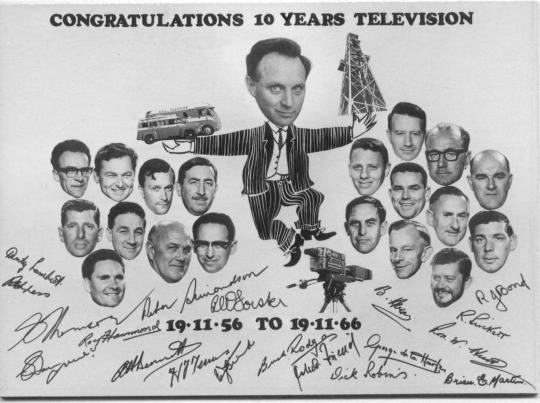
(A card celebrating the first ten years of ABC broadcasting in Victoria - supplied: Andrew Best)
#television#belinda hawkins#mark farnell#andrew best#props#staging#ripponlea#television production#australian story
5 notes
·
View notes
Text
COVERING CYCLONE DEBBIE
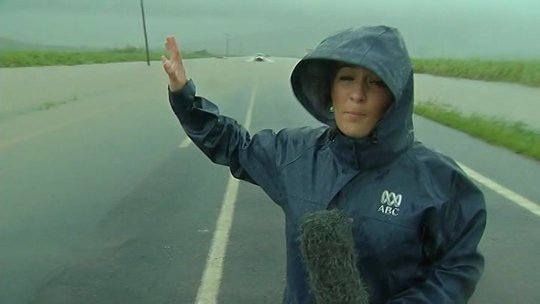
(Allyson Horn recording an ‘As Live’ report from the flooded Bruce Highway - Photo: ABC News)
Covering the impact of Cyclone Debbie and the subsequent floods that hit Queensland and NSW was a huge undertaking for News, Regional and Radio staff. Here, Brisbane based News reporters Allyson Horn and Josh Bavas and Regional chiefs of staff Fidelis Rego and Chrissy Arthur discuss the challenges of reporting on the cyclone and keeping audiences up to date.

(Allyson Horn doing an early morning cross from Proserpine, Qld - Photo: ABC News)
ALLYSON HORN, NEWS JOURNALIST:
“Covering Cyclone Debbie meant moving around a fair bit as the tracking projections changed. I started in Townsville, then went to Ayr and after that I covered one of the hardest hit areas, Proserpine. All up, I was in the cyclone hit area for about a week. Cyclones generate so much interest, and because of that, everyone wants crosses and information - so I filed for a lot for different programs.
Mainly I was filing for News (radio and TV), local radio, doing live crosses and continually feeding the online blog with pictures and quotes. Then there were international requests and I did Skype interviews with the BBC, multiple radio crosses with stations in Japan, Singapore, London, America, and various places in Europe. It was go, go go.”

(Allyson Horn recording a Skype cGross to the BBC - Photo: Steve Cavenagh)
“Cyclones are so unpredictable, which is why we moved around so much. The biggest consideration with this is judging safety - knowing where to go and when to do it! We had reporters and crews stationed in all the major towns which could have been impacted. Given my previous experience as a journalist based in North Queensland, my bosses trusted my local knowledge of where we could go, what roads would be flooded, when to go into lockdown, and which crews were best placed to get to other areas.”
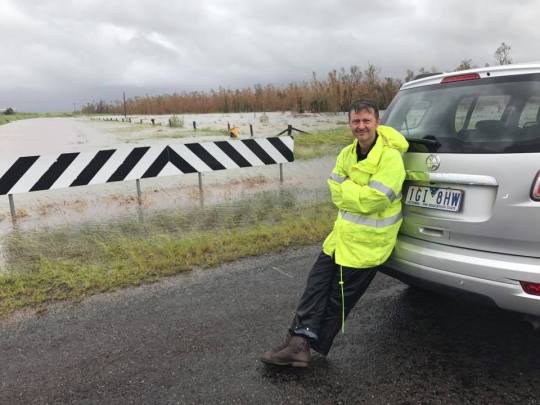
(Camera operator Steve Cavenagh takes a break beside the flooded Bruce Highway - Photo: Allyson Horn)
“Getting to affected communities was most difficult after the cyclone when many areas were cut off by flood waters. We spent eight hours on the side of the Bruce Highway waiting for floodwaters to recede, just so we could get into Proserpine. It was one of the hardest hit towns, with houses and properties demolished. We were the first news crew in there and the residents were so grateful they hadn't been forgotten.”

(Allyson Horn and Steve Cavenagh at Proserpine - Photo: ABC News)
“Another challenge was fatigue management. Most days would start at 3am, to be ready to start reporting from 4am (which at that point, was 5am Sydney time). I’d usually work solidly from then on, providing live crosses, covering the unfolding story, gathering the elements for my TV news package, scripting, and then doing more live crosses for evening programs. After that, there were more live crosses for radio stations and planning the next day, before getting to sleep around midnight.”
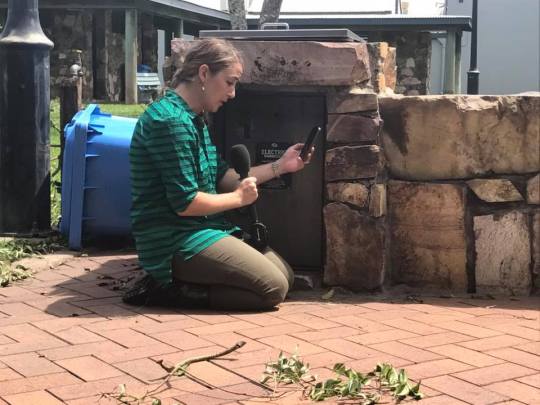
(Allyson Horn finding shelter from the wind to record her voice over - Photo: Steve Cavenagh)
“Sleep was often interrupted, because we were running on adrenaline. As a team, we took breaks when and where we could, we made sure everyone was eating and drinking, and shared responsibilities (our links operator Dean Caton sometimes took over shooting, to give cameraman Steve Cavenagh a break). Being in a consistent team was important and provided great support for everyone.”

(Cameraman Steve Cavenagh and links operator Dean Caton take a break while Allyson Horn writes her script in the background - Photo: ABC News)
“No phone or internet connection was another challenge. You can get the best stories, pictures and information on the road, but it means nothing if you have no way of broadcasting it. We shot some amazing vision and found some great stories around Proserpine but the mobile phone towers were down, and it was too windy at our location on the Bruce Highway to set up the MSAT (mobile satellite). A generous local offered for us to go back to his house to see if it would work better there. When we arrived, we saw he had lost his home.”

(Dean Caton operating the MSAT - Photo: Allyson Horn)
“Through some amazing team work, we managed to get the MSAT up, using a satellite phone to contact the office. At the same time, Steve and I filmed a stand-alone walk through with the resident about the damage to his property. Drone operator Jano Gibson also managed to get some amazing aerials. All this in the space of half an hour! The lesson in these situations is, be ready to change your plans and always be looking for opportunities.”
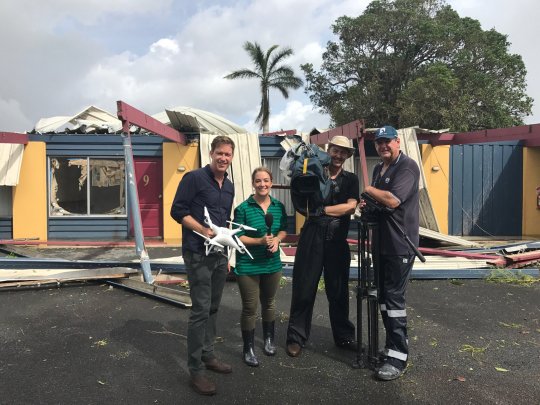
(L-R: Drone operator Jano Gibson, Allyson Horn, Steve Cavenagh and Dean Caton at Proserpine - Photo: ABC News)
“On top of those challenges, there were no showers, lack of food, no electricity to charge phones, sleeping on the floor of the evacuation centre. Luckily, all our team had covered multiple cyclones and knew what to expect and it was a minor inconvenience compared to what residents affected by the cyclone were dealing with. We sure appreciated our beds and showers when we got home, though!”

(Allyson Horn recording her voice over under a blanket - Photo: ABC News)
“There were some memorable moments: we were sleeping on the floor of an evacuation centre in Proserpine when it was was suddenly flooded. That was a sleepless night. We were camped with 70 firefighters (boy could they snore) and about 500 ml of rain fell, leading to water coming in the door. Luckily, we had our rain jackets as pillows, and some Tim Tams and ration packs to see us through the night!
The other part of reporting on a cyclone that always sticks with me is the people, who despite losing so much, are always so generous with their time, knowledge and thoughts. I can't reinforce how much the ABC is respected and trusted in these situations, and this was a comment made to me over and over again throughout our coverage of Cyclone Debbie and the aftermath.”
FIDELIS REGO, CHIEF OF STAFF, ABC TROPICAL NORTH:
“Based in Mackay, ABC Tropical North’s preparation began on the weekend before Debbie made landfall. Staff brought in supplies, bedding, food, etc. and a special joint breakfast program was mounted out of Townsville on the Sunday before the cyclone, to help locals prepare for what was to come.”

(All hands on deck during the cyclone - ABC Tropical North lead reporter Mel Maddison reading a news bulletin as her daughter watches on - Photo: Fidelis Rego)
“We began our rolling emergency coverage from 4am on Tuesday, March 28, the day the cyclone made landfall, and we provided non-stop coverage until 3pm. In that time, the local breakfast and mornings presenters hosted most of the coverage, with help from ABC Capricornia Chief of Staff Chrissy Arthur and producer Cathy Border. They also handled the hundreds of requests for crosses from ABC bureaux around the country. Some of our local staff also provided crosses to international media. As Chief of Staff, it was my job to coordinate coverage, manage external cross requests, and look after staff. At the height of the emergency, we slept in the office.”
“The main challenge we faced was the loss of our transmitter the day after the cyclone. We lost it for a full day, however we continued to provide vital information to our local community online and via social media. Having extra staff sent in before the cyclone was great, especially given their experience and local knowledge. They acted as mentors to the younger team members and were a steady pair of hands.”

(Reporter Lara Webster out and about covering the impact of the cyclone - Photo: ABC Tropical North)
“As much as possible, we tried to keep our local presenters on air for extended periods throughout the crisis. The feedback we had was that was what the community wanted. In times of emergency or crisis they want to hear information from people they know and trust. Our local staff knew exactly who to call to get that information, what roads would be cut, what creeks would start to flood and were able to pass on that information to our audience well before other media.”
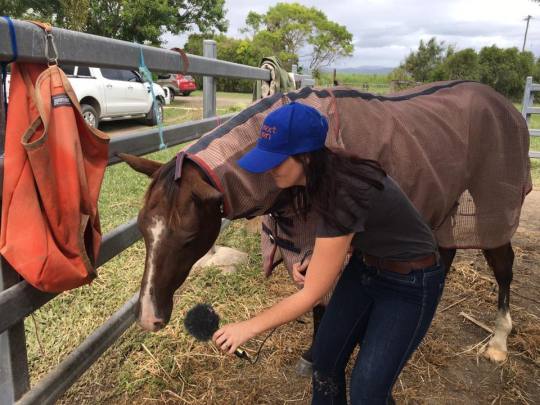
(Lara Webster getting all perspectives on the cyclone impact - Photo: ABC Tropical North)
CHRISSY ARTHUR, CHIEF OF STAFF, ABC CAPRICORNIA:
“ABC Capricornia was heavily involved in emergency broadcasting and newsgathering throughout Cyclone Debbie and the aftermath, as major flooding hit the Central Queensland region.”

(Aerials of flooding at Rockhampton - Photo: ABC News)
“I travelled to Mackay to assist with coverage as the cyclone made landfall, but days later was travelling back to Rockhampton to prepare for the flood emergency. Bundaberg’s Chief of Staff Scott Lamond also travelled to Rockhampton to support the local crew, and the Regional Drive team of Loretta Ryan and Cathy Border came to assist. There were also numerous news and current affairs reporters who visited during the week to provide ongoing coverage.
The team of local reporters and presenters provided emergency information in extended radio programming, via social media and online and also filed news content for radio, TV and digital platforms across the week. In the initial stages, ABC Capricornia also faced the prospect of being inundated by floodwaters. Our building fronts the Fitzroy River and early forecasts meant we were potentially at risk. We had sandbags and water pumps delivered, but thankfully the water didn’t reach the predicted height and we remained high and dry.”

(Watching the swollen Fitzroy River - Photo: ABC Capricornia)
“The Fitzroy River is a very slow moving system: we began extended emergency broadcasting on Sunday morning and the river didn’t peak until Thursday afternoon. We had the luxury of plenty of time to prepare the community and the local Disaster Management Group said this was the “most well-informed” flood event Rockhampton had been through. The Queensland Premier and Queensland Police Commissioner made a personal visit to our station to thank the ABC for its role in emergency broadcasting and helping to keep people safe.”

(Queensland Premier Annastacia Palaszczuk and Police Commissioner Ian Stewart dropped in on ABC Capricornia staff to congratulate them on coverage of the Rockhampton floods - Photo: ABC Capricornia)
“Among the highlights of our coverage was the growth of our social media channels, but our content across all platforms featured important local information and also personal stories of how people were preparing, responding and then recovering”

(ABC Capricornia kept local residents up to date on its Facebook page.)
“We worked to get information to people via several platforms and that was shared widely and helped the community to prepare and stay safe. Central Queensland is also a big region and it wasn’t just Rockhampton that flooded. We were able to quickly get reporters to other parts of Capricornia which had been devastated by flooding. The content generated from these smaller communities and outlying areas was powerful and compelling.“

(Josh Bavas reporting live from Bowen during Cyclone Debbie - Photo: ABC News)
JOSH BAVAS, NEWS JOURNALIST:
“Cyclone reporting is anything but glamorous. There was a moment when that reality sank in – somewhere between having a ‘shower’ with wet-wipes and eating dry Nutri-Grain and ginger beer for lunch. It’s a little hard to stay presentable when there’s no power, no water and of course, no coffee!”
vimeo
The view from Josh Bavas’ motel doorway of a tree snapping as Cyclone Debbie sweeps into Bowen - Video: Josh Bavas).
“Our reporting team of four was cooped up inside three small motel rooms in Bowen during the cyclone and we weren’t exactly sure what the town would look like when we finally emerged. Anyone who sat out Debbie in the dark will tell you how stressful it was to be inside for hour upon hour, listening to the wind howling through the windows and roof.”
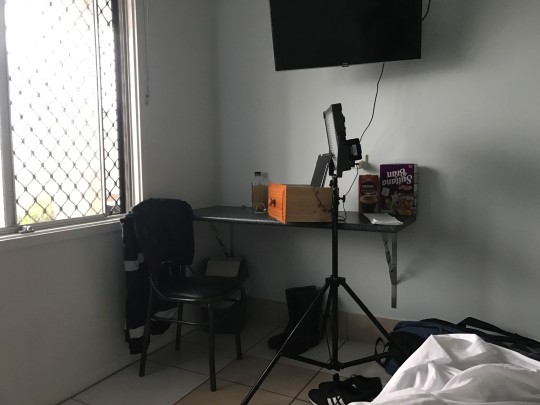
(Bowen motel ‘studio’ – ipad and light set up for live crosses during the cyclone crossing when it was too dangerous to go outside - Photo: Josh Bavas)
“It’s when all the planning is finally tested: Did we pick the best position before the cyclone hit? Is it a strong building? Are we out of the tidal surge zone? How will we access power to continue rolling coverage? And where do we need to go once the storm has passed?
vimeo
Russel Talbot filming on the Bowen foreshore the day before the cyclone hit - Video: Josh Bavas
“I had previously covered two cyclones in Bowen (Cyclone Ului in 2010 and Cyclone Anthony in 2011) but these were completely different; they were nowhere near as big or slow as Debbie. Cyclone Anthony blew in as a category two cyclone one Sunday night, taking out a couple of windows in the local hotel and by Monday morning, Bowen was virtually back up and running.
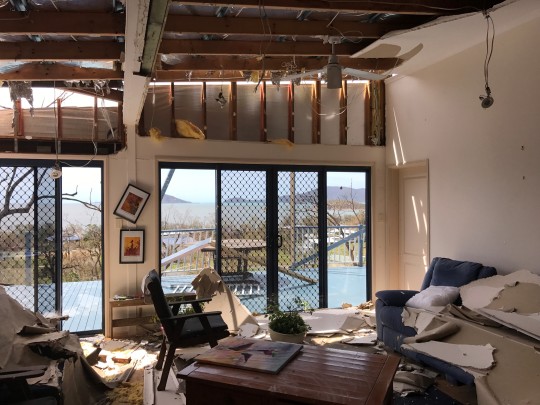
(Inside a cyclone damaged home at Hydeaway Bay - Photo: Josh Bavas)
“Cyclone Debbie took her time and overstayed her welcome, leaving a trail of destruction in her path. She left thousands of people scrambling without water, power and food and sent tourists packing.”

(Josh Bavas cooking sausages for the ABC team camped in Bowen - cameramen Scott Kyle and Russel Talbot and radio reporter Annie White - Photo: ABC News)
“The night after Debbie passed, our cameraman Scott Kyle reminded us of a packet of sausages we packed away in an esky with ice. After a day of cold wind, soggy gum boots and round the clock reporting, we finally had the chance to cook up a dozen hot delicious snags. It's funny how low your food standards drop when there's little to go around.”
RELATED STORIES:
Cameraman’s wild night covering Cyclone Debbie
How ABC North Coast team kept community informed while stranded in flood zone
Drone camera captures the scale of Cyclone Debbie destruction
Cameraman reflects on harrowing assignment covering Tumbulgum tragedy
#allyson horn#josh bavas#steve cavenagh#cyclone debbie#queensland#nsw#floods#dean caton#russel talbot#annie white#scott kyle#bowen#proserpine#cyclones#disaster coverage#news coverage#television#radio#chrissy arthur#fidelis rego#abc capricornia#abc tropical north
1 note
·
View note
Text
Cameraman's wild night covering Cyclone Debbie

(Russel Talbot shooting floods in Rockhampton after sitting out Cyclone Debbie in Bowen - Photo: Jonathan Hair)
News cameraman Russel Talbot was based in Bowen during Cyclone Debbie. Here, he explains the challenges he faced shooting the storm and the aftermath.
By Russel Talbot
My story begins on the night after Cyclone Debbie hit and involves a lightning storm to make even Thor proud.
vimeo
(Russel Talbot shooting the Bowen foreshore during wild weather associated with Cyclone Debbie - Video: Josh Bavas)
Our ABC crew was stationed in Bowen, Qld. The day before was challenging. As Debbie crossed, fellow cameraman Scott Kyle, reporter Josh Bavas and I were camped in motel rooms in the centre of town. Debbie was a slow, gruelling cyclone. She took almost the whole day to finish her sweep of the area. The rain bucketed down all day, but we were lucky, as the power didn’t go out till about 2pm. Telstra managed to keep 4G up the whole time, which helped us a lot.
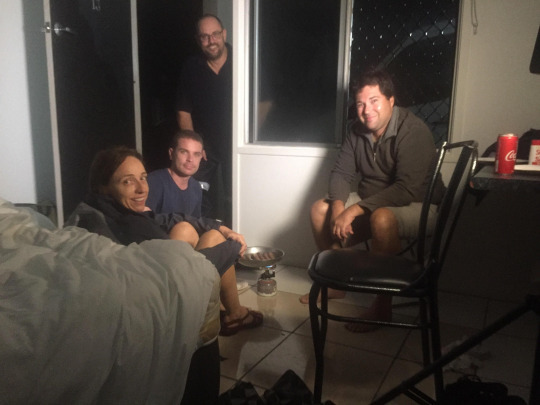
(The ABC Bowen team in the motel where they sheltered from the cyclone - radio reporter Annie White, news reporter Josh Bavas and cameramen Scott Kyle and Russel Talbot - Photo: Scott Kyle)
The shoot was challenging, but the motel offered us a car park that was on the leeside of the wind. We filmed the main street when it was safe and Josh reported radio and TV crosses from his motel room. Water had started leaking through the window of his and Scott’s room around lunchtime, but lucky me had an awning out the back so I was on dry feet all day! (A fact I mentioned many times to everybody.)

(Josh Bavas doing a cross from the Bowen motel room - Photo: ABC News)
So, the night after Debbie hit Bowen, we were doing crosses into the 7pm Queensland news. The wind had stalled, but the rain had been increasing and then the lightning began. We found a safe location under a business awning with the main street as the backdrop. We got cover from the rain and set up all the lights. The rain was too heavy for the link truck so we had to use the LiveU, (which uses the mobile phone network) so, again, great that Telstra stayed up!
Reporter Josh Bavas was doing a rehearsal for the 7pm news when a large bolt struck the Telstra tower 30 metres from us. The tower still stood and then an explosion of thunder ripped through our ears and tore through our bones. Luckily, it was a rehearsal as Josh left the camera frame quick smart! After covering my ears and seeing Josh ducking for cover we all had a quick laugh.
The 7pm cross went to air without any more intruding rumbles and then the Whitsunday mayor was up for a live interview. During that, there was another large strike, a little farther away. The mayor flinched, but remained stoic. I rode the sound levels as the thunder threatened to distort my audio. I was thinking the whole time we just need to get through another hour of this. We had a few more crosses to go. The gear was holding up in the weather, though everything had that damp feel to it from the 100% humidity. My spare charged batteries were running low, the shooting time to charging time ratio had been highly in favour of shooting. And I kept glancing at that Telstra tower hoping we could get by without another strike.
Our crosses finished, we returned to the motel when I got a call from another cameraman. A video camera had been left behind in a chopper at the Bowen airfield due to a mix-up and they needed us to pick it up.
The rain was now torrential. The airfield was a five minute drive out of town. Josh came with me and we slowly and carefully drove out there as the rain poured, the sky lit up in bright flashes and water threatened to cut the roads.
Despite our best efforts to get the camera out from that chopper, we decided it was just too dangerous and we’d pick it up in the morning. We drove back to the motel, the roads were covered in about six inches of water, not from creeks, but from the rain that was falling. I thought we’d be on flood coverage the next morning.
It was sunny! Damn, I was glad to see the sun the next morning. Three days of torrential rain was starting to make me grumpy. And the day wasn’t too hot! The next day after a cyclone is usually stinking hot with 80% humidity and zero breeze.
Josh and I started looking for clean-up stories and we found a family and a young man who’d had a lucky escape. I filmed the remains of a large pine tree that had fallen through a bedroom window, narrowly missing the young man. We got the vision of the young bloke and the family wheelbarrowing all the debris around and then it was time for an interview with the mother.
Her name was Debbie Breeze.
Yeah, we questioned that one, but it checked out.
In an attempt to provide a brief moment of light relief, I said to Josh, ‘Think of all the puns you could use,’ while chuckling wryly.
#cyclone debbie#behind the lens#television#russel talbot#josh bavas#queensland#cyclones#disaster coverage#news coverage
1 note
·
View note
Text
BEHIND THE SCENES OF NEWS BREAKFAST’S BUDGET COVERAGE
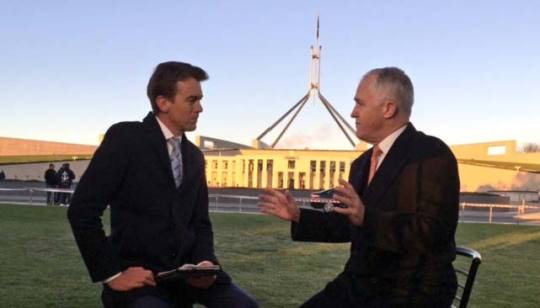
(News Breakfast host Michael Rowland interviews Prime Minister Malcolm Turnbull live from Canberra the morning after Budget 2017 - Photo: ABC News)


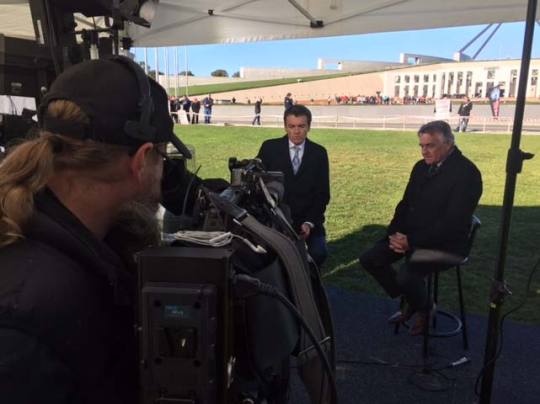
(Michael Rowland and Barrie Cassidy - Photo: ABC News)

(Keeping the croissants warm on a chilly Canberra morning - Photo: ABC News)
1 note
·
View note
Text
How far has News Digital come in 20 years?

(L-R: News Digital’s founding editor Bob Johnston in the newsroom named after him with current Managing Editor Stuart Watt and Director of News Gaven Morris - Photo: Tim Leslie)
At a recent function to mark the 20th anniversary of ABC News Digital, the Brisbane headquarters of the service was renamed the ‘Bob Johnston Newsroom’. As current Managing Editor Stuart Watt writes, it’s a fitting tribute to News Digital’s founding editor.
By Stuart Watt
It’s fair to say Bob Johnston played a key role in shaping the ABC News division we know today.
Bob was a pioneer of digital news in Australia. He launched ABC News Online – now known as ABC News Digital – 20 years ago, when the world wide web was first taking hold in popular consciousness.
vimeo
VIDEO: This video produced in 1998 explains the News Online operation in the early days, followed by a video outlining the scale of News Digital today.
Bob would be the first to admit he had no idea what lay ahead. But there’s a reason for that – no-one did. When we established News Online’s first newsroom, just six of us in a converted underground carpark on the ABC’s old Toowong site in Brisbane, we had an inkling that the internet could become quite important. But we had no idea it would be such a dominant force for societal change, or that it would shake-up the news business forever.
In those days, broadband was a distant dream. Access via a 56k modem (remember that sound!) was the “information superhighway”. I remember the buzz around the office the first time we added a photo to a story. Where would this technical wizardry end? We have come so far in the intervening two decades. And much of the credit for that progress can be sheeted home to Bob.

(Bob’s surprise when he saw the sign ‘Bob Johnston Newsroom’ unveiled - Photo: Tim Leslie)
These days we all accept digital is an important part of the news mix. For younger Australians, it’s the primary platform for news consumption. But 20 years ago, it was little more than a distraction. Why would we invest time, effort and (heaven forbid) money in what was clearly a novelty? Surely in TV and radio, we had pure news media. This internet thing would never catch on. When we suggested segmenting stories from the 7pm news to distribute online, we were lectured on the “synergy” of the 7pm bulletin. “The whole is greater than the sum of the parts,” we were told.
A lesser man would have folded in the teeth of what varied from ambivalence to outright hostility. But not Bob. It’s due to his tenacity that News Online was able to grow. From six people to eight, eight to 12, then to 18, 20 and beyond. Today, there are more than 100 people in digital roles across the News division.

(L-R: Stuart Watt, Bob Johnston and Bob’s son Nathan - Photo: Tim Leslie)
So what kind of a leader was Bob? First and foremost, he was a journo’s journo. Bob has a great nose for a story. He started his career in newspapers in Townsville, before joining the ABC bureau as a radio reporter there. Eventually he came to Brisbane where he reported on politics for radio news. He moved into management, serving as the Queensland Radio News Editor until that post, and its TV equivalent, were merged after the 1996 Federal Budget.
While no luddite, Bob was never quite on the cutting edge of new technology. But he was a great champion for those who were. He fostered a great spirit of experimentation in the News Online newsroom, never afraid to try something new. In his time at the helm we racked up an impressive list of firsts – the first rolling, online breaking news service in Australia, first with “read for the web” audio bulletins, first to post regional news online, first with TV-style video news – even at a time when only a handful of Australians could view such a service, so appalling were dial-up speeds.

(Stuart Watt and his Digital team celebrate 20 years - Photo: Tim Leslie)
To do all this Bob had to win the funding argument with people who thought he was speaking a different language. He cajoled, begged, pleaded and threatened to win resources. And he was cunning – in a good way, of course. If there has been a better “operator” in the ABC in the past 20 years, I’d like to shake that person’s hand.
Bob also had a great capacity to inspire people, to lay out the vision and to win from them complete buy-in. This was vital for our survival. From the very start, News Online recruited young go-getters with very little experience. But Bob also had to convince experienced broadcast journos to leave the safety of radio and TV and take a punt on us. That so many of them did is a credit to their professional bravery, and to Bob’s ability to sell them the fairytale.
Once you were on the News Online team, it was easy to give Bob 100 per cent loyalty. We knew he would go to the barricades and stare down the guns for us, even when we were in the wrong. In return, he demanded our best, every shift, every week. And he wasn’t above giving a bollocking. The unfortunate person would be summoned to his office, the door would shut, the venetian blinds would be twisted shut and a sombre silence would descend on the newsroom until the victim emerged. He was always fair, but Bob could be hard when he had to be.

(Director of News Gaven Morris talks about the significance of the phone in journalism today - Photo: Tim Leslie)
Almost everything we do in digital spaces at ABC News today owes its origins to Bob, but his greatest legacy is less tangible. In his time as News Online’s editor, Bob built a team with an amazing culture. It’s tough being the digital disruptor in a broadcast organisation. It would be easy to wallow in self-pity. But Bob wouldn’t allow that. Our approach was to strive for continuous improvement, to pull together – one cohesive unit striving to serve our audience as well as possible every day. It’s a culture that has built incredible resilience and seen the team punch above its weight to this day. There is nothing the News Digital team cannot cope with. And that’s due to the traits Bob instilled in the team from its earliest days.
For 13 sometimes difficult years Bob battled every day to build the service that more than 4 million Australians now use every month. He’s done it with great integrity and with his own brand of self-deprecating humour. He’s been a great mentor and friend through some incredibly difficult times for many.
This month we recognised that contribution by naming the Brisbane HQ of News Digital the Bob Johnston Newsroom. It’s a fitting tribute to a great news man.
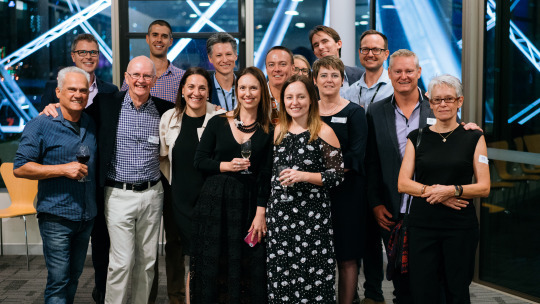
(Bob Johnston with some members of the original News Online team - Photo: Tim Leslie)
More stories about ABC News Digital here.
Click here to return to the Back Story home page or catch up on stories from the past four years on our archive page.
4 notes
·
View notes
Link
2 notes
·
View notes
Link
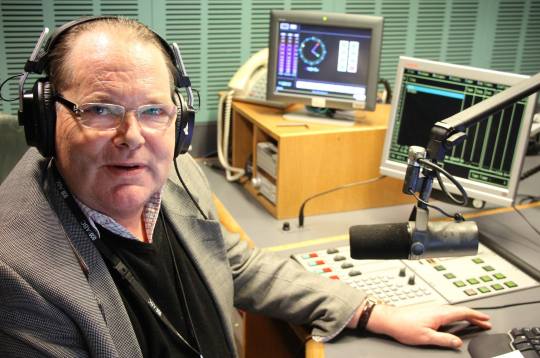
ABC journalist Mark Colvin dies aged 65 after struggling with a rare auto-immune disease for more than 20 years.
Click here for previous stories about Mark Colvin on Back Story.
7 notes
·
View notes
Text
NSW FLOODS: HOW ABC NORTH COAST TEAM KEPT COMMUNITY INFORMED WHILE STRANDED IN FLOOD ZONE

(Bruce MacKenzie filming in Lismore as the water rose - Photo: Samantha Turnbull)
By Samantha Turnbull
Teachers from the kids’ schools called on Thursday afternoon: “Come and pick them up – we’re closing for the next few days, floods are coming.”
It wasn’t news to us. The rain had been falling in incessant glass sheets for hours. My husband, Bruce MacKenzie, and I work as reporters at ABC North Coast in Lismore, and our station had been broadcasting flood watches and warnings throughout the day.
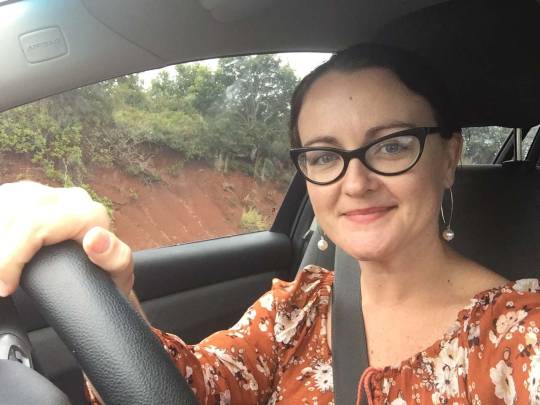
(ABC North Coast reporter Samantha Turnbull - Photo: supplied)
The trouble was, the schools are 45 minutes east of Lismore and we couldn’t get to them because every road there was already under water. It happened too quickly. The situation was the same for most of us in the office – our children needed collecting. Thankfully, my parents live in a place from where they could get in and so they did a mercy dash, then babysat our children around the clock for the next week as work went into full emergency broadcast mode.
Cyclone Debbie was no ‘Queensland only’ phenomenon. Its remnants, combined with record-breaking downpours that had already pelted our region, meant northern New South Wales bore the brunt of a clichéd ‘recipe for disaster’.
Many of us were stranded that Thursday. Chief of Staff Justine Frazier, producer Pam MacIntosh, reporter Donna Harper, and Bruce and I booked the last two rooms in a Lismore motel when it became clear we couldn’t get home. Then we all had to evacuate at 3am Friday as the city’s flood levee was about to be overtopped. Our motel went under a few hours later.

(Ballina Road, Lismore – the address of the motel ABC North Coast staff were staying in before it went under water - Photo: Samantha Turnbull)
A month on, those first three days have become quite the blur. I know I didn’t change my clothes in all that time and the office air conditioner couldn’t seem to do the job when I hung my drenched socks in front of the vents to dry. I spent a lot of those initial hours manning the station’s social media accounts, feeding an insatiable hunger for photos and ‘as-live’ videos from key locations that locals could use a basis to determine when they would need to abandon their own homes. Meanwhile, user-generated photos and videos from across the region were flowing in thick and fast showing causeways and roads washed away and tips of rooftops peeking through inland seas of brown.

(Breakfast presenter Joanne Shoebridge broadcasting from the Murwillumbah train station, one of the flood recovery Outside Broadcast sites - Photo: Destination Tweed)
Our breakfast team Joanne Shoebridge and Pam Macintosh doubled their hours on air for the next three days keeping our audiences informed with the latest official information, in between taking calls from locals who often repeated the same frustrated line: “We didn’t expect it to be so high.”
Our six-person team grew as reporters from as far afield as Melbourne flew to our region to assist. Many of them were called in to help specifically because of their knowledge of our area: Sydney’s James O’Brien grew up in Lismore, reporters Margie Burin and Justin Huntsdale have both spent time working out of the ABC North Coast office, and Fiona Wyllie was a long-serving morning presenter here before she moved to hosting Statewide Drive.
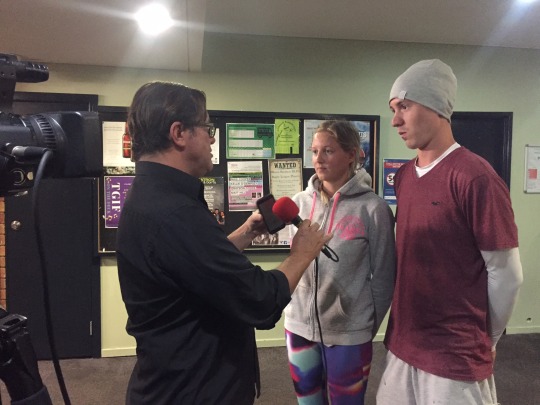
(Bruce MacKenzie interviewing a young couple at the Red Cross evacuation centre in Lismore - Photo: Samantha Turnbull)
For all of us, this was the biggest flood we had ever covered. Lismore, Murwillumbah, Billinudgel, Coraki are all flood towns. We’re used to a bit of putrid murky water. But this one, this one was different. It was faster and higher than we’d seen in decades. The only people who seemed to be ready for it were my 80-year-old grandparents who lost everything on their first floor, but had raised the second storey of their Lismore home after the 1974 floods got in. In the Tweed, the Bureau of Meteorology called it a 1 in 1000 year flood.
Part of my job as a features reporter was to trudge the littered streets in the aftermath, interviewing countless bewildered people who thought they’d prepared, but hadn’t successfully. There were people who’d woken up to water pouring through their windows, people who’d woken up on floating beds, people who had to swim for their lives though torrents that took the lives of others.
The story that affected me most was that of the Greenhills Caravan Park in South Murwillumbah, the town’s only caravan park which was home to 50 permanent residents. I spoke to many who lost everything and are now living in tents at the local showground. But they considered themselves lucky. Their neighbour Mark Austen was found dead in his van that had been completely swallowed by water.
As I walked the streets for the next few days, I had a basic routine: record interview, take photos, record video, edit, send back, do live cross, post to social media, repeat. A dozen interviews a day was nowhere near enough to tell the stories of everyone deeply affected by what had happened.
It will be many months, years even, before our region recovers and for our jobs of telling our community’s stories to be done.
Read more about Cyclone Debbie coverage here.
#regional#samantha turnbull#cyclone debbie#nsw floods#lismore#disaster coverage#emergency broadcasting#radio#news coverage
1 note
·
View note
Text
NEWS STUDIO IN REFURBISHED SOUTHBANK HQ NAMED IN MEMORY OF SATIRIST JOHN CLARKE

(Michelle Guthrie speaks to staff in the new foyer of the Southbank building)
ABC Managing Director Michelle Guthrie joined staff in Melbourne to celebrate the completion of the redeveloped Southbank Complex and announce that the new state of the art news studio will be named after satirist John Clarke, who died last month.

(Satirist John Clarke - Photo: ABC News)
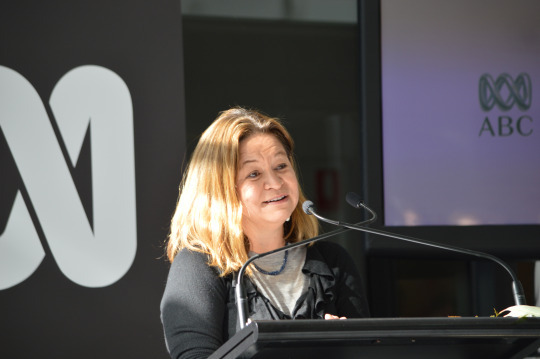
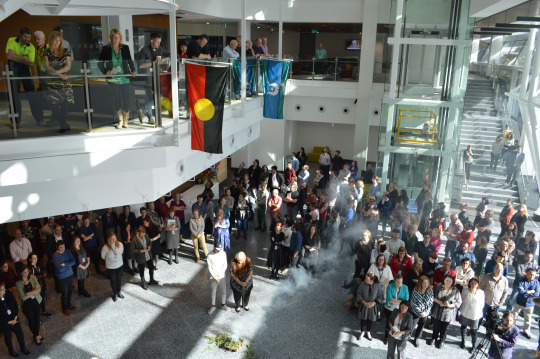
Wurundjeri Elder Aunty Di Kerr conducted the Welcome to Country and smoking ceremony.

The building will be officially opened on Thursday by the Miniser for Communications and the Arts, Mitch Fifield.
)

Photos: Natasha Johnson
1 note
·
View note
Text
DRONE CAMERA CAPTURES THE SCALE OF CYCLONE DEBBIE’S DESTRUCTION
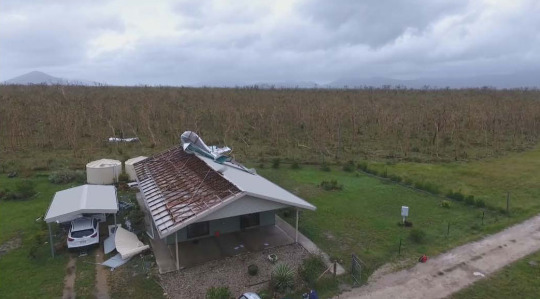
(A photo taken from an ABC News drone of a cyclone damaged house at Proserpine and a huge area of trees, stripped of their leaves - Photo: Jano Gibson)
NT based journalist Jano Gibson is one of the ABC’s recently-trained drone operators and in the aftermath of Cyclone Debbie he was deployed to North Queensland to capture aerial footage of the destruction at Proserpine.
By Jano Gibson
I’ve always been fascinated by storm chasers: the crazy-brave enthusiasts who travel each year to America’s Tornado Alley, hoping to get as close as possible to the violent columns of swirling wind and debris.

(Jano Gibson operating the drone in Proserpine - Photo: ABC News)
Right now, as I stand on the muddy driveway of a rural property in Queensland’s Whitsunday region, I’m feeling a bit like one of those storm chasers. Sheets of metal roofing lie strewn on the grass outside, literally peeled away by cyclonic winds that pummelled this property.
“Once the roof came off, it got pretty scary,” owner Nathan Sainsbury tells me. “We gradually moved from the hallway, to a bedroom, ended up in the bathroom.”

(Resident Nathan Sainsbury in front of his damaged home - Photo: Jano Gibson)
It’s been more than 24 hours since Cyclone Debbie blasted through this area, and it’s only now that the wild, blustery conditions are beginning to ease enough to safely launch a drone, officially known as a Remotely Piloted Aircraft (RPA).
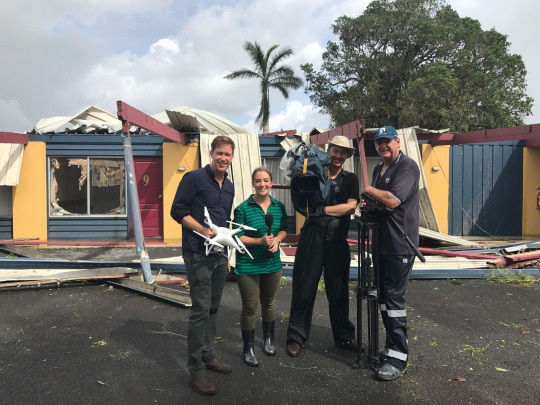
(L-R: Jano Gibson and his drone with reporter Allyson Horn, cameraman Steve Cavenagh and links operator Dean Caton at Proserpine, Qld - Photo: ABC News)
In my normal role as chief-of-staff back in Darwin, I’m usually sitting at a desk coordinating our afternoon news coverage. But I’ve come here to Queensland as a recently-trained drone pilot to work alongside reporter Allyson Horn, cameraman Stephen Cavenagh and links operator Dean Caton. We’re all scrambling to meet a fast-approaching 7pm News deadline.
For the past seven hours, we’d been stuck nearby on a stretch of flooded road, unable to reach our desired destination - the cyclone-hit town of Proserpine. With time running out, we made the call to leave the highway and head several kilometres away to this rural property, which we’re been told has been heavily damaged.
As we drive along a dirt road, it’s easy to imagine how frightening it would have been for the Sainsbury family to ride out the cyclone while their relatively-new home was ripped open. The floor tiles are still wet from the drenching they copped, and the trees surrounding the property are stripped of leaves.

(The Sainsbury’s damaged home - Photo: Jano Gibson)
But it’s not until the DJI Phantom 4 rises above the two-storey home that the full scale of the damage becomes clear. One side of the roof is gone, and as I watch the drone’s live-camera feed on my remote control, I can see directly into Nathan Sainsbury’s upstairs bedrooms. Peering into what was once a private space is somewhat unsettling, and I’m grateful Nathan has given us permission. This smooth, slow-moving, bird’s-eye perspective is something no camera on the ground can capture.
vimeo
VIDEO: Drone footage shot by Jano Gibson of the damage to the Sainsbury family home and other buildings in Proserpine.
As the drone glides overhead, a huge gust of wind whips through. Even with its integrated GPS system, the quadcopter struggles to hold its position. These conditions are close to the limit of if its flying capacity; its four engines working hard as I shift the remote’s levers to direct the drone back to my position.
A month earlier, I completed a week-long course to get what’s known as a Remote Pilots Licence (RePL). On a personal level, I was finally fulfilling a childhood dream of becoming a ‘pilot’. On a professional level, a RePL is a requirement if you want to fly commercially in Australia drones that weigh more than two kilograms. The DJI Phantom 4 that I’m using here in Queensland is below that weight, and so falls into a less-restrictive category known as an “Excluded” Remotely Piloted Aircraft. So while a RePL isn’t legally essential for this particular craft, the ABC insists all staff wanting to fly drones must be licensed and the course itself is invaluable. As well as the basics of the drone regulations, the course provides knowledge in:
- multi-rotor aerodynamics, including roll, pitch and yaw;
- airspace categories and navigational charts;
- essential safety information about LiPo batteries;
- how to seek approvals to fly in restricted or dangerous areas;
- and the use of aeronautical radios.
During the course, you clock-up five hours of flying time – the minimum requirement to get a RePL. You also must pass a knowledge exam and a flying test, including tricky manoeuvres without the assistance of GPS.

(Jano Gibson learning to fly the drone in Tasmania before the cyclone - Photo: ABC News)
Those skills come in handy as I guide the drone safely back to its makeshift landing site – a large, heavy mat on Nathan Sainsbury’s driveway, ensuring the drone’s camera doesn’t get muddy as it touches down.
The first challenge - flying in the aftermath of a cyclone - is over. But now another challenge looms – feeding the drone vision out.
The SNG has already been used to send out cameraman Stephen Cavenagh’s vision and Allyson Horn’s voice over for the 7pm News bulletin. There’s only a matter of minutes left to get the drone vision out. The DJI Phantom 4 shoots in high-definition, but to send shots via the SNG, we need to down-covert using something called a Decimator. For an unknown reason, the system isn’t working as it should.
We try to think of alternative solutions: we could edit the vision on my mobile or use Adobe Premiere to down-convert the vision and email it out. But both options aren’t possible because there’s no mobile reception here.
I’m beginning to feel deflated when cameraman Stephen Cavanagh comes up with a simple solution. He uses his P2 camera to film the drone vision as it plays on the laptop screen. His recording is then fed out using the SNG. Problem solved.

(The drone view of a plumber’s workshop devastated by Cyclone Debbie - Photo: Jano Gibson)
As dawn breaks the next day, we get our first look at the damage within the town of Prosperpine. It’s not as extensive as we’d expected, but some properties have been structurally destroyed, including a plumber’s workshop, which looks like it’s been hit by a tornado. As the drone buzzes overhead, it captures the tools and materials that were flung around inside the premises.

(The drone view of a damaged Proserpine motel - Photo: Jano Gibson)
A few hundred metres away, we come across a motel that’s been torn apart by Debbie.
“The damage is just astronomical, never seen anything like it before,” Proserpine Motor Lodge owner Peter Stokes tells me after I finish flying the drone over his business.
“Gone through other cyclones. The other ones were not too bad, you’d sort of say it was a freight train coming. This one was just worse, probably 10 times worse.”
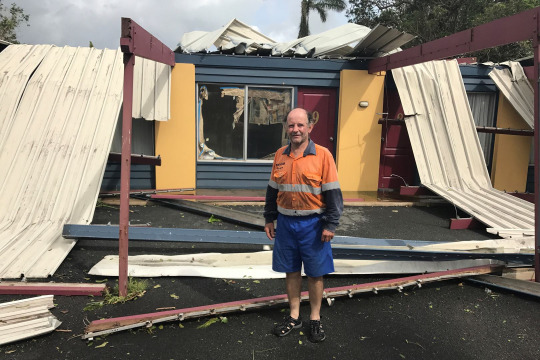
(Proserpine businessman Peter Stokes in front of his damaged motel - Photo: Jano Gibson)
Whether it’s for natural disaster coverage, or current affairs stories, drones are fast becoming an indispensable part of our newsgathering kit. They provide a sense of scale that previously only a helicopter could offer. And with their in-built gimbals, they capture smooth, high-resolution vision that’s hard to compete with. But they also come with risks and have the potential to crash into buildings or people if not operated safely. It’s essential that as we expand our use of drones, we do so sensibly.
On this trip, it was necessary to have a dedicated drone operator. The other members of the team were completely tied up with their primary roles as they serviced multiple platforms. But as the ABC continues to develop its drone capabilities, it makes sense for more people to get licensed to fly drones. That way camera operators, SNG operators and reporters can all be called on to fly a drone when the need arises.
Read more about ABC News’ use of drones here.
Click here to return to the Back Story home page or catch up on stories from the past four years on our archive page.
#jano gibson#qld#cyclone debbie#proserpine#allyson horn#dean caton#drones#cyclones#disasters#steve cavenagh#behind the lens#camera#television
0 notes
Text
CAMERAMAN REFLECTS ON HARROWING ASSIGNMENT COVERING DEATHS OF TUMBULGUM FAMILY IN FLOODED TWEED RIVER

(Journalist Jade Macmillan reporting from Tweed River at Tumbulgum, NSW - Photo: Matt Roberts)
Canberra based cameraman Matt Roberts usually spends his day filming political stories at Parliament House but at the height of the Queensland and NSW floods he was deployed to cover the tragic deaths of Tumbulgum mother Stephanie King and her two children, who drowned after their car plunged into the swollen Tweed River. It was a difficult and distressing assignment for Matt, a father of two young children, and reporter Jade Macmillan.
By Matt Roberts
It was the exact type of story that I would normally avoid. I often switch off heartbreaking TV stories of death or loss before they start and I won’t click on similar topics online, especially when families, and in particular, children are involved. I’m not trying to be rude or disrespectful to anyone, I just don’t want to get upset. I have two young kids and I'm so soft I’ll cry if my son gets up at school assembly to accept a ‘Student of the Week’ award.
Then Tumbulgum happens. I’m thrust into the harrowing tale of Stephanie King and her three kids Ella Jane, Chloe May and Jacob. Stephanie King was driving down Dulguigan Road by the banks of the recently flooded Tweed River in northern NSW, lost control of her car on the muddy asphalt and tragically plunged into the murky waters. Amazingly, 8 year old Chloe May managed to escape via a window, swam to shore and frantically alerted the nearest neighbour, screams I’m sure that neighbour won’t forget in a hurry.

(Camera operator Matt Roberts shooting a flood affected farm near Murwillumbah, NSW - Photo: ABC News)
I’m a camera operator based at Parliament House in Canberra and I was sent to Brisbane to help cover the floods gripping that region. Cyclone Debbie had recently struck north Queensland and as a consequence a lot of ABC crews and journalists from Brisbane were sent up north, leaving a shortfall back at their home base. I had only covered one previous flood at Bundaberg, QLD, in 2013 and the thing I remembered most was the mud, smell and the cleanup once the flood water had retreated.

(Flooding at Beenleigh, QLD - Photo: Matt Roberts)
It was a long day first up, providing crosses from Brisbane for News Breakfast and then from flooded Beenleigh all afternoon and evening. Then the instructions came through late that evening to pick up a Sydney journalist from Coolangatta Airport at 6.30 am the next day. I had never met Jade Macmillan before and had no idea where the trip would end up taking us.

(A flooded home at Beenleigh, QLD - Photo: Matt Roberts)
We spent most of that Saturday trying to get into the town of Murwillumbah, which was inundated by flood water. We tried the main roads and the back roads to no avail. One of many that we attempted was called Dulguigan Road. We exchanged numbers with some locals who were also trying to get in but the flood waters were too high and all the roads were cut off.

(The muddy aftermath of the flood - Photo: Matt Roberts)
On Sunday, we were tasked with reporting on the health concerns caused by the flood. This assignment took us to sewage plants, water processing centres and eventually we reached Murwillumbah.

(A crushed truck swept by flood waters into a railway bridge in South Murwillumbah, NSW - Photo: Matt Roberts)
It’s hard to get across on TV the scale of the destruction from a flood. So many houses and businesses had been inundated. So many piles of ruined household items lined the streets. So many people were helping with the cleanup. Everyone had a story to tell. And while I felt uncomfortable filming these residents at their most vulnerable, I kept reassuring them that my job was to get this vision out to tell their stories of survival and to potentially bring outside assistance.

(Jared Wyborn shovels mud from the front of his home on Railway St, Murwillumbah, NSW - Photo: Matt Roberts)
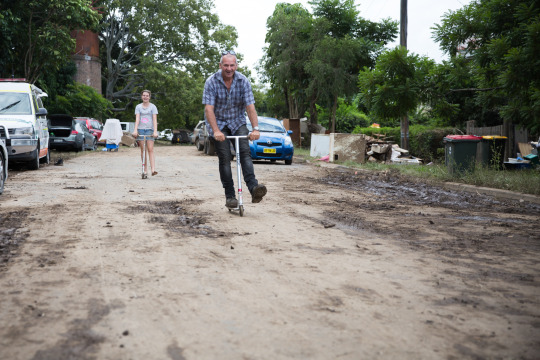
(A brief moment of fun amid the devastation as residents take a break from the cleanup at Murwillumbah, NSW - Photo: Matt Roberts)
On Monday morning, we were out at a dairy farm just outside Murwillumbah, reporting on the impact on agriculture. 83 year old farmer Pat McDonald told us how he lost some cattle but miraculously saved most of his herd on a tiny elevated bit of backyard. We visited a muddy sugar mill and organic food business and covered the fly-in, fly-out visit of the Prime Minister and NSW Premier. As we were feeding our vision back and farewelling our link operator Ross McLoughlin, we got a call about a possible car accident in which a family with kids had been swept into flood waters.

(Links operator Ross McLoughlin setting up the MSAT to send vision from the flood zone to Sydney - Photo: Matt Roberts)
We called one of our local contacts immediately so we could get directions to Dulguigan Rd. The road was blocked at exactly the same place we saw it blocked on Saturday, but this time not because of flood water. We retreated and drove around the now familiar back roads to the small town of Tumbulgum, where we could see a police operation underway across the river. Jade found a local resident who told us how he jumped into the river to try to rescue the family. He could see the bubbles from the vehicle but couldn’t find or reach it. Despite his immense bravery, he felt helpless.
An unforgettable Tuesday was then underway. Arriving before first light, the squelchy trek through the thick mud to the riverbank for live crosses soon became routine. Squally rain blew through regularly, bringing eerie rainbows and damp equipment. The car and three bodies were still on the bottom of the swollen river, and the names and ages of the victims were becoming known to the growing media contingent. The youngest victim Jacob, was the same age as my son. The surviving father was named Matt. The story was really starting to hit home. Police divers had entered the Tweed and Jade was somehow managing to run through the details of this tragedy not just hourly for TV, but for radio and online too.
With a 7pm news package beckoning we couldn’t stay at the riverbank all day. We pooled resources with a commercial network and weaved our way through the Tumbulgum cleanup to try to find some residents who knew Stephanie King and her children and were comfortable talking to us about them. It was a difficult task, every house was flood-affected and the small community had just lost three members. There were emotional residents who understandably detested the media presence and there were others who welcomed us but were too upset to be interviewed on camera.
Jade managed to find Dan Purkis, the local soccer coach who knew the family of Stephanie King. I apologised for sticking a camera in his face. He ran through each member of the family. “Ella Jane, she's a good kid, a smart kid. Chloe May, she's our goalie. She's a very tenacious young lady.” Everything started to get blurry in my viewfinder when he started talking about Jacob. “Cheeky little fella, best little smile. I loved it when he'd come up to me and give me a high-five.” The bodies and the van were retrieved from the river and the police held an emotional press conference. Word came through that Stephanie King’s body was found cradling one of her deceased children.
Late in the day, the media gained access to the stretch of road where the van had entered the river and reluctant live crosses and pieces to camera were recorded. It didn’t feel right being there so soon after the accident. There were no flowers yet and I wanted to write a note to the family but the road was still closed to the public and I didn’t want to be the first.
The day was drawing to a close. We had one last live cross off the back of our 7pm package. As we were packing up, a resident we’d met earlier approached us for a chat. She was friends with Stephanie King and her own house had been damaged by the flooding, but she still asked us how we were going and whether we needed anything. She was just one of many people we met along the way whose resilience and generosity blew us away.
This was a difficult assignment to cover and I was fortunate enough to have Jade on my side. I couldn’t have had a better colleague in the field to help me cover this harrowing story. It was challenging professionally and emotionally for both of us, but she reported with dignity, sensitivity and respect the whole time. We’ve both had plenty of support from colleagues across the ABC and fortunately I completed peer support training a month earlier, so Jade was in pretty good hands too!
I returned to Canberra the next day and received some pretty special hugs from my family, but I was only home for twenty minutes before I had to take my kids to the school disco. They knew I was covering the floods but didn’t know a thing about the Tumbulgum tragedy. I watched them dance their little hearts out to the song ‘Happy’ and I somehow held it together.
Read more about dealing with traumatic news stories here.
Click here to return to the Back Story home page or catch up on stories from the past four years on our archive page.
#matt roberts#cyclone debbie#floods#nsw#qld#local#behind the lens#tumbulgum#stephanie king#tweed river#jade macmillan#covering traumatic events#television#camera
2 notes
·
View notes
Text
ABC NEWS DIGITAL TEAM WINS WALKLEY EDITORS LAB HACKATHON
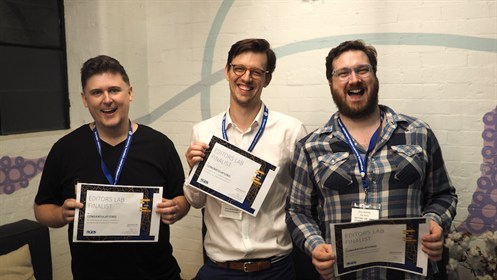
(Hackathon winners from the Digital Storytelling Team - Ben Spraggon, Simon Elvery and Colin Gourlay - Photo: Kate Golden, Walkley Foundation)
News Digital’s Ben Spraggon, Simon Elvery and Colin Gourlay took out first prize at the Walkley Editors Lab hackathon with a prototype encryption tool called Initiate, which makes it easy for the public to send secure news tips to journalists. They beat teams from News Corp, Fairfax, The Conversation, SBS, AAP and more to win both the People’s Choice Award and first place from a panel of judges from The New York Times, Google Creative Lab, the Online News Association, the Global Editors Network and the Walkley Foundation. They’re now heading to Vienna in June to compete in the International Editors Lab final, dubbed “the World Cup of newsroom innovation”. Here, they explain their award winning innovation and what happens next.
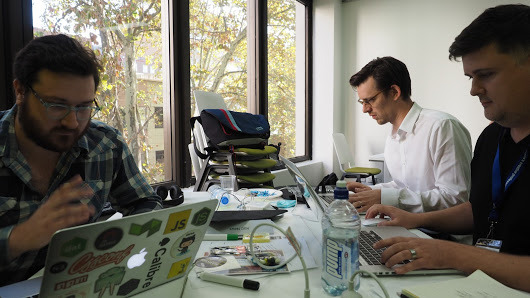
(Colin, Simon and Ben hard at work at the hackathon - Photo: Riley Wilson, Walkley Foundation)
First up, can you explain what the Walkleys Editors Lab is?
Simon Elvery: The Editors Lab is an event run by the Global Editors Network (GEN) and (in Australia) the Walkley Foundation aimed at encouraging technical innovation in newsrooms. It's what's often called a 'hackathon'. There are Editors Lab events happening throughout the year in cities all around the world.
And for the uninitiated, what actually happens at a hackathon?
Simon Elvery: A hackathon is a short event where small teams of people compete to create a fast solution to a problem of their choice, usually based around a theme. The Editors Lab hackathon is focused on getting journalists, designers and developers working together to implement prototype solutions to real problems in media.
Ben Spraggon: A hackathon is an opportunity to get together with like minded people to quickly innovate solutions to specific problems- a kind of “brainstorming” with user experience design and code. Often the results of a hackathon are the seeds of a solution worth developing into a fully-fledged product.

(Talking about innovation at the Editors Lab hackathon - Photo: Riley Wilson, Walkley Foundation)
Tell us about Initiate, the tool you prototyped. What is it?
Simon Elvery: Initiate is our solution for bringing down the barriers to entry for people who want to communicate securely with journalists without significantly compromising safety.

Where did the idea for Initiate come from?
Simon Elvery: As with most good hackathon ideas, it came from our own desire to have such a thing. We were 'scratching our own itch'. Our team at the ABC had been talking about how to leak to journalists for a long time and were frustrated at the lack of options for soliciting sensitive input from the audience in a way which is completely private.
What problem is it trying to solve?
Simon Elvery: The primary problem is how to make it plausible for a non-technical audience member to use encrypted communication with a journalist. Secondary to this we wanted to educate the audience as much as possible about the risks associated with leaking sensitive information - just because the content of a communication is private, the fact you've had that communication may not be.
Colin Gourlay: There are so many ways an attempt to leak information to a journalist can fail at the very beginning. We want to make that very first step safe and secure, allowing both parties to foster a meaningful relationship.
Why does that matter?
Simon Elvery: The engagement of journalists with their audience could always do with improvement. If we can make sure it's as easy as it possibly can be for someone to contact a journalist securely, it makes it more likely we can bring important stories to the public.
Ben Spraggon: Anything that helps lower the barrier for a member of the public to help uncover an important story is worth pursuing, especially if complexity or fear are what’s stopping that story from being told. On top of this, educating the public and other journalists about the risks involved is a worthy goal in itself.

(The team presenting their prototype - Photo: Riley Wilson, Walkley Foundation)
How did you approach the process of creating a prototype for a tool like this in just two days?
Simon Elvery: The first part is all about idea validation. We came into the morning of the first day with a few possible ideas, but none that had really stuck. After an initial discussion we settled on this as our preferred option and set about validating that it was actually possible both technically, and to have something approaching a working prototype in the time frame. We'd validated that by just after lunch on the first day so spent the remainder of the time madly implementing.
With most hackathons (this one included) there's also an element of pitching at the end of the event. So some portion of the second day was dedicated to polishing a pitch presentation.
Colin Gourlay: We were quite lucky to be able to produce a proof of concept in the first day (not all hackathon teams are as fortunate), which let us use the better part of the second day to refine the experience and make it as simple to use as we could within the time constraints.
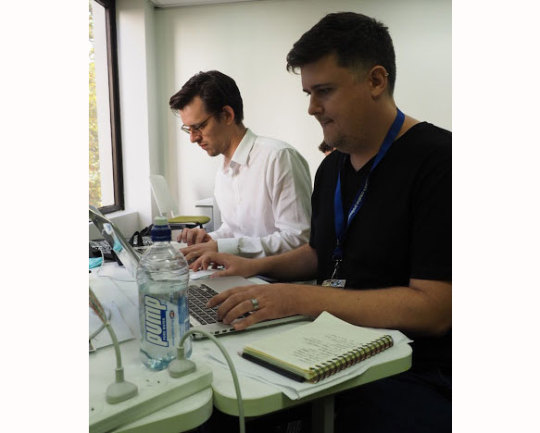
(Simon Elvery and Ben Spraggon working under time pressure to produce their prototype - Photo: Riley Wilson, Walkley Foundation)
What were some of the other tools that news organisations created?
Simon Elvery: Among the highlights were several novel methods for the audience to provide feedback to journalists and leave comments, deeply immersive storytelling techniques, and making tools for the newsroom to organise around the audience easier. For a full list visit the GEN website.
Colin Gourlay: Because of the limited time we had, most of the teams tried to leverage existing platforms to avoid re-inventing the wheel. While we built upon some cryptographic technology provided by Keybase, it was great to see a variety of avenues explored by the other teams, including Google Street View, Slack and Facebook Messenger.
Why do you think Initiate won the day?
Simon Elvery: It's hard to say, there were a lot of strong contenders. One thing I think which stood us apart was our interpretation of the theme 'audience engagement'. Many teams took the route of trying to create experiences for the audience which are highly engaging (a perfectly valid choice), whereas we chose to interpret it as finding a way to directly interact with the audience.
Two other things which I think contributed to the judges positivity toward our effort was that we had a functionally complete, minimum viable product which was reasonably polished, and that we made the whole thing open source.
So, the prize is a trip to Vienna. What will you be doing there?
Simon Elvery: Another hackathon! The idea of the GEN Editors Lab events is that they happen all around the world and the winners from each individual event go to Vienna to compete in a 'final' or sorts.
Colin Gourlay: The Editors Lab, for me, is a great excuse to meet and socialise with all of the people in Australia who do what we do. We’re a relatively small community of journalists, designers and developers, and I’ve returned from the event full of energy to innovate further and produce compelling stories for our audience. To be able to now go to Vienna and meet and be inspired by people like us from all over the world; I don’t have words for how excited that makes me.
And what happens to Initiate now?
Simon Elvery: Now we're trying to find a way to bring it from being a functional prototype to something ready for production use at the ABC (and possibly elsewhere). Stay tuned.
More stories about innovation here.
Click here to return to the Back Story home page or catch up on stories from the past four years on our archive page.
#hackathon#walkleys#walkley editors lab#simon elvery#ben spraggon#colin gourlay#digital#digital storytelling team
1 note
·
View note
Text
WHAT NEXT FOR ABC NEWS? DIRECTOR GAVEN MORRIS OUTLINES HIS VISION AT THE MELBOURNE PRESS CLUB

(Director of ABC News Gaven Morris addresses the Melbourne Press Club lunch - Photo: MPC)
In an address to the Melbourne Press Club in March, ABC News Director Gaven Morris has spoken about the future of journalism in the digital age and his vision to ensure television and radio stories have an ‘equal digital life’ and reach new and broader audiences.
“A big story told well with a trusted brand can reach bigger audiences than we ever imagined when we [only] had radio and television. If you’ve got a taxpayer funded service to provide trusted news and information, our task has got to be to at least try our very hardest to be as relevant as we possibly can to the broadest cross-section of the community. That doesn’t mean that everything we do must be relevant to every single person, but we have got to be trying our hardest to show every Australian value for every dollar they’ve invested in us.”
Watch the speech in full here.

(Gaven Morris with Michael Rowland, News Breakfast host and Melbourne Press Club President and Barrie Cassidy, Insiders host - Photo: MPC)
#gaven morris#equal digital life#melbourne press club#mpc#barrie cassidy#michael rowland#journalism#news talk
1 note
·
View note